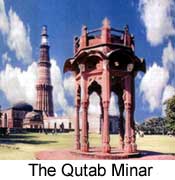Many of New Delhi's best-known landmarks lie on a line running east to west through the city. The line starts at the National Stadium. Then it passes through the Children's Park and the War Memorial Arch along the impressive Raj Path, through Central Vista Park, to Rashtrapati Bhavan (the residence of the president of India).

A similar line running north-south, known as "Janpath," goes from the main shopping centre, Connaught Place, to residential suburbs. Several districts retain their own character. The Civil Lines, originally laid out to house British colonial officials, is now a residential area for well-off Indian government officials. A large industrial area, Okhla, is on Mathura Marg in the south.
Kotla Mubarakpur has the appearance of a sprawling country village. Chanakyapuri is an area set aside for foreign embassies. The vast sports complex, built for the 1982 Asian Games, contains a stadium that seats 30,000 people. Delhi also has India's finest zoo, with rare white tigers.
Delhi contains what are probably the finest monuments in any city in India. The Qutab Minar, one of the city's most famous sights, is a 5-storey, 72-metre tower of red sandstone. It was begun in 1199 as a symbol of Muslim victory and power and used for hundreds of years by muezzins (mosque officials) calling the faithful to prayer.
Near the Qutab is one of Delhi's most remarkable sights, a simple pillar, set up about A.D. 400. It weighs over 6 metric tons, stands more than 7 metres high and has never rusted. The citadel of Tughluqabad was a major centre of power for about ten years in the 1300's and has been a wasteland of ruins ever since. In the beautiful Lodi Gardens is the cemetery of the Lodi kings, who ruled India from Delhi during the 1400's and were overthrown by the Mughals in 1526.
Shah Jahan's Lal Qila (Red Fort) dates from the 1600's. Its walls of red sandstone enclose elegant halls and pavilions where the Mughal emperors held lavish ceremonies and gave audience to subjects and ambassadors. The Jama Masjid is the biggest mosque in all India and was also built by Shah Jahan.
Continue with Delhi's History.....



